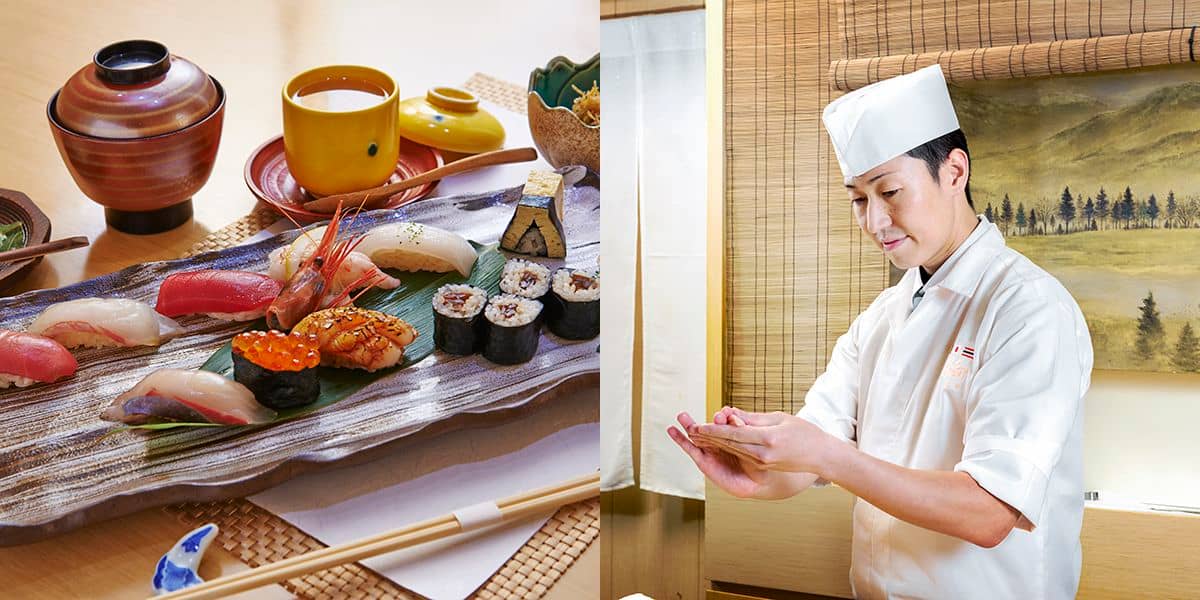
Cookbook Writer Tim Anderson Feeds the UK’s Growing Love for Japanese Food
London-based chef, writer, and broadcaster Tim Anderson is the author of seven Japanese recipe books, from classic Japanese home cooking to Tokyo specialties and ramen. As a well-known voice on Japanese cuisine in the UK for over 13 years, he has seen Japanese food grow in popularity and Japanese ingredients become much more available.
But his own Japanese food journey started back when he was a student in the US. It was one particular bowl of ramen that, as he puts it, “changed his life.” In hindsight, he says it was a relatively ordinary bowl of tonkotsu (pork bone) ramen, but aged 19, it was a revelation.
“It was salty, it was fatty, it had umami, it was complex,” he says. “I’d had ramen before, but none of it was that good. It had a real sensory impact.”
Growing up in the midwestern US state of Wisconsin, Anderson was a fan of Japanese pop culture. This prompted him to major in Japanese studies at a Los Angeles college, and in 2005 he received a grant to research noodles in Japan. After a stint teaching English in Fukuoka, southern Japan (a place not-uncoincidentally famous for noodles,) in 2008 he moved to the UK with his girlfriend, who later became his wife.

Chef and cookbook writer Tim Anderson at his London home
Before long, he came across a program on UK TV called MasterChef. On a whim, he applied to the popular competitive cooking show, and ended up winning the 2011 series. The dishes that impressed the show’s judges were inspired by his American heritage, the UK’s food traditions, and his passion for Japanese food.
That success led to Anderson’s restaurant Nanban, which opened in 2015 in the Brixton area of London. It mainly served food from southern Japan, but Anderson also sourced ingredients from local markets and took inspiration from Brixton’s multicultural mix of Caribbean, West African, and Latin American cuisines.
From restauranteur to cookbook writer
Within a few months of opening his restaurant, Anderson published his first cookbook, also called Nanban. A modest success, it was followed by his breakthrough 2017 book Japaneasy. The aim of this second cookbook, says Anderson, was to introduce easy-to-cook classic and modern Japanese home food. But of course, in order for readers to cook the recipes, they needed the right Japanese ingredients.
“I said that if you can get soy sauce, miso, mirin, sake, rice vinegar, rice itself, then either some kind of instant dashi (fish stock) or the ingredients to make dashi from scratch, you can make a huge range of Japanese dishes,” says Anderson.
Since then, a much wider range of Japanese ingredients have become available to UK shoppers. For example, recently a friend asked Anderson to recommend a good-quality Japanese soy sauce. In the past, there would have been almost nothing available, he says. But this time when he checked online stores that sell Asian ingredients, he was spoiled for choice.

Tim Anderson has been a well-known voice on Japanese food in the UK for over a decade
Yet, says Anderson, the main online and physical UK supermarkets where most people do their shopping haven’t caught up with these specialist retailers.
One large online supermarket, he notes, sells katsuobushi (bonito fish flakes) but not konbu (kelp,) which is the other ingredient essential for making dashi fish stock. And he would love to see major UK supermarkets offer instant dashi powder, a popular shortcut in Japanese kitchens.
“Japanese home cooking doesn’t have to be laborious,” he says. “There are a lot of instant products being used, and they’re great.”
As a long-time ramen aficionado, another wish is for UK supermarkets to stock fresh noodles.
“A noodle dish can have great toppings. You can have great dashi. You can have great seasonings, broths, everything like that. But if the noodles themselves are not very good, it doesn’t taste right.”
But the hardest Japanese ingredients to find, says Anderson, are fresh produce such as fish, vegetables, and fruit.
“The fruit in Japan is unbelievably delicious compared to most of what we get here,” he enthuses.
As a recipe book writer, he would love home cooks to use authentic Japanese ingredients wherever possible.
“There are particular Japanese flavors: dashi and koji (a mold used in fermentation) based seasonings like sake, miso, and soy sauce. If you don’t have those, or if you don’t get them right, it’s not going to taste Japanese.”

Tim Anderson testing recipes for his upcoming book on Hokkaido cuisine
The better availability of Japanese ingredients is part of a gradual richening of the UK’s food culture, says Anderson.
“I moved here 15 years ago, and the amount of interest in other [non-British] types of food has really exploded. You get things like local specialties and there’s a lot of emphasis now on sustainability, and good farming, and quality meats.”
The number of Japanese restaurants has also exploded, particularly in London, which is home to the largest Japanese expat community in Europe. This began with restaurant chains such as Wagamama and YO! Sushi in the 1990s and has expanded to everything from cheap takeaway sushi to premium omakase (chef-chosen menu) and kaiseki (traditional multi-course) dining.
Anderson highlights some exceptional Japanese restaurants far from London. In the Welsh capital of Cardiff, there is a restaurant that serves a plant-based tonkotsu (traditionally pork bone) ramen and a now-closed restaurant in Aberdeen that served sushi made with fresh fish from the local Scottish coast.
Yet, Japanese food in the UK tends to be quite conventional, something often true for other imported cuisines as well. For example, cities such as New York and Chicago (and indeed Tokyo) have their own distinct versions of pizza, says Anderson, but Italian restaurants in London tend to forgo such evolution for a focus on “authentic” Italian pizza. Likewise, Japanese restaurants in the UK often try to faithfully recreate standard dishes.
This may be because Japanese food is relatively new to the UK, compared to countries such as the US, and has had less time to evolve. But one notable exception, he says, is a ramen restaurant in North London that serves Philippines inspired halal ramen. Another sign of experimentation is the recent fashion for Japanese-fusion restaurants, notably the Peruvian Japanese cuisine known as Nikkei, but also Japanese and Italian, French, Brazilian, Mexican, or Korean fusion.
An affinity for comfort food
Yet, despite the ever-greater variety of Japanese food now on offer to UK diners and consumers, Anderson senses a particular affinity for what might be called Japanese “comfort food” with its “big, hearty flavors.” Examples include not just ramen, but katsu curry, tonkatsu, and okonomiyaki.
Perhaps it is no coincidence that some of these everyday Japanese dishes have a cultural connection with the UK. Japanese curry has its roots in old-fashioned English curry, albeit with deeper roots in India. A key component of tonkatsu and okonomiyaki sauces, meanwhile, is Worcester sauce, a UK condiment created during the first half of the 19th century.
Anderson also notes the traditional structure of a UK meal, often served on a single plate and dubbed “meat and two veg.” It is quite different to the typical Japanese meal of small dishes served on several plates and might help explain why “one-dish” Japanese meals such as ramen and katsu curry have become so popular in the UK.

Some of Tim Anderson’s books on Japanese food
Anderson’s seven published cookbooks contain not only such comfort foods, but also recipes that reflect the breadth of Japanese food’s popularity in the UK. As well as his Nanban and Japaneasy books there is a book on ramen, on Tokyo food, on izakaya (casual restaurant) dishes, and on bowls and bentos.
Perhaps a little surprisingly, his most popular book is Vegan JapanEasy: Classic & Modern Vegan Japanese Recipes to Cook at Home. But Anderson comments that the book fills a unique niche in the cookbook market, and that vegan readers have appreciated the book design, ease of the recipes, and how it gives them a fresh cuisine to try out.
His eighth book, due to be published this October, will be on food from Japan’s northernmost island of Hokkaido. There will be seafood recipes such as kaisendon (seafood bowl) and crab korayaki (cooked in the shell.) It will also have a section on ramen, dishes that use the island’s famous dairy products, and several recipes from the Ainu indigenous ethnic group of Hokkaido. (According to Anderson, it may be the first mainstream English cookbook to feature Ainu cuisine.)
Japanese food relies on good, fresh, ingredients
So, what next for Japanese food in the UK? For chef and writer Anderson, it all comes down to ingredients. At the time of writing, he is testing recipes for his upcoming Hokkaido cookbook and busily sourcing the authentic Japanese foods he needs. He says that he uses about a dozen online supermarkets regularly, including four that specialize in Japanese and Asian ingredients.
A positive legacy of the recent Covid pandemic, he says, is that people in the UK are now much more accustomed to shopping for food online, giving them better access to a range of Japanese ingredients. But that is still no replacement for fresh food from a local store.
“So much of Japanese food relies on having good produce, having good fish available, having good miso,” he says.
Despite the much better availability of Japanese foods in recent years, there is still plenty of space on UK supermarket shelves for more. And as Japanese food becomes ever more popular in the UK, consumers’ hunger for top quality ingredients from Japan is only likely to grow.






